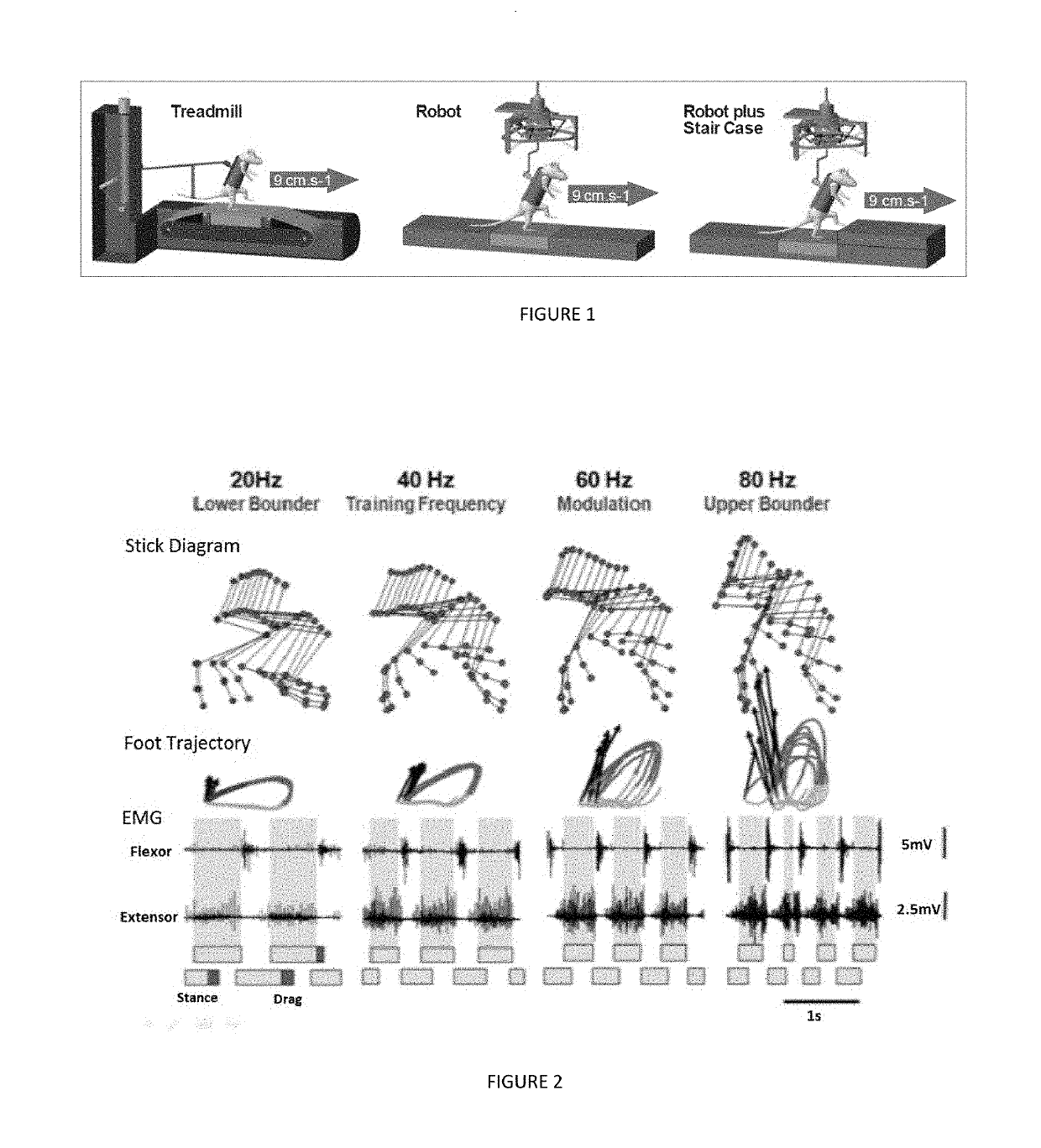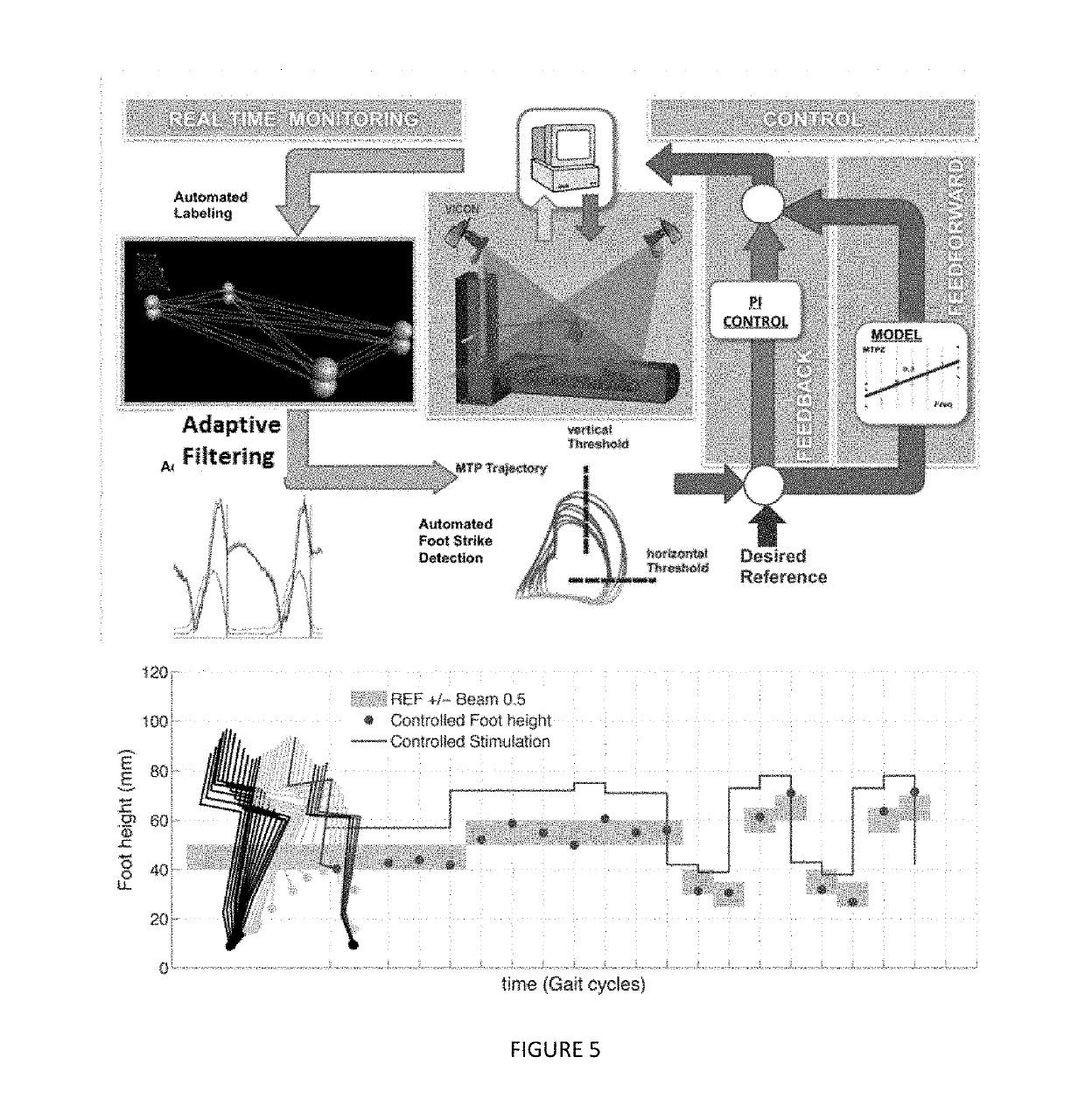System to deliver adaptive epidural and/or subdural electrical spinal cord stimulation to facilitate and restore locomotion after a neuromotor impairment
a technology of electrical spinal cord stimulation and epidural and/or subdural electrical spinal cord stimulation, which is applied in the field of neuromotor impairments, can solve the problems of inducing lower stepping and eventually collapse, and achieve the effect of minimal delay
- Summary
- Abstract
- Description
- Claims
- Application Information
AI Technical Summary
Benefits of technology
Problems solved by technology
Method used
Image
Examples
example 1
[0210]Effect of Epidural Electrical Stimulation on Bipedal Stepping
[0211]Experimental Procedures
[0212]All experimental procedures were approved by the Veterinary Office of the Canton of Zurich. The experiments were conducted on 7 adult, female Lewis rats (˜220 g). The rats were housed individually on a 12 h light / dark cycle, with access to food and water ad libitum. All spinal cord-injured animals received manual expression of the bladder twice a day and stretching of the hindlimb flexor and adductor muscles once a day to prevent joint contractures. Additionally, all animals were put together into a large cage three times a week to meet their social needs.
[0213]After surgeries (complete midthoracic transection of the spinal cord at level T 6 / 7), two epidural electrodes implanted at spinal segments L2 and S1, and two electromyographic (EMG) electrodes chronically implanted on both legs for the TA (Tibialis Anterioris) and MG (Gastrus Medialis) muscles), all rats were allowed to recov...
example 2
[0224]Closed-Loop Control Based on SISO Models
[0225]Closed-Loop Monitoring and Control Setup
[0226]A Vicon Kinematic System (Nexus) acquired 3D coordinates of reflective marker positions in real time (200 Hz) according to a user-defined kinematic model (markers for: Crest, Hip, Knee, Ankle and Foot, for both legs), built on a per-animal basis for high accuracy tracking. The acquired coordinates were then transmitted through the Vicon Data Stream to an external Personal Computer via an Ethernet port. On the external Personal Computer, our C++ program was programmed to interface simultaneously with the Kinematic Data Stream and the TDT Program Code (RZ5 Bioamp Processor, TDT). The C++ Code was programmed to detect foot-strike in real time and adapt the stimulation using the linear model previously built (FIG. 5), as mentioned in example 1, thanks to the presence of a controller. Thus, a closed-loop control structure has been established.
[0227]Controller Structure
[0228]The input-output ...
example 3
[0244]Functional Applications
[0245]Fighting Fatigue for Improved Rehabilitation.
[0246]We then tested the capacity of the presented model and controller to be employed for applications that might prove useful form a rehabilitation perspective.
[0247]One of the major motivations that underlie controlled electrical stimulation, either when referring to EES or FES (Functional Electrical Stimulation), is that it may help to compensate for the fatigue that often derives from an external source of muscle activity. In the framework of EES-induced locomotion, fatigue yields a decreased flexion and extension pattern during stepping over time, and hence inducing lower stepping and eventually collapse.
[0248]Here we tested whether the present controller could be employed to ensure that consistent stepping heights are maintained over time, as a way to fight fatigue. We quantified the duration of good stepping in both controlled and non-controlled (constant 40 Hz) trials, and we show (FIG. 9) that ...
PUM
 Login to View More
Login to View More Abstract
Description
Claims
Application Information
 Login to View More
Login to View More - R&D
- Intellectual Property
- Life Sciences
- Materials
- Tech Scout
- Unparalleled Data Quality
- Higher Quality Content
- 60% Fewer Hallucinations
Browse by: Latest US Patents, China's latest patents, Technical Efficacy Thesaurus, Application Domain, Technology Topic, Popular Technical Reports.
© 2025 PatSnap. All rights reserved.Legal|Privacy policy|Modern Slavery Act Transparency Statement|Sitemap|About US| Contact US: help@patsnap.com



